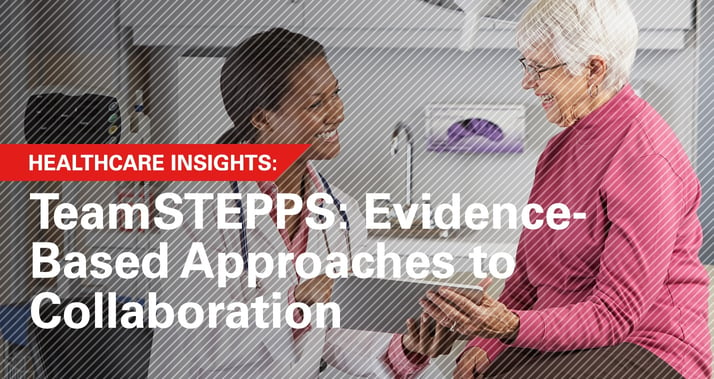
Every day in healthcare settings across the continuum of care, healthcare professionals are faced with obstacles that in many cases are caused by breakdowns in communication and collaboration, particularly across disciplines such as nursing, medicine, and environmental services. Due to the increasing complexities that exist across the continuum of care, it is more important than ever to have access to evidence-based tools and methodologies that can improve patient safety and clinical outcomes.
The Agency for Healthcare Research and Quality (AHRQ) has launched version 2.0 of the TeamSTEPPS program that is a well-researched framework which focuses on improving teamwork across the healthcare delivery system. Originally, TeamSTEPPS was launched from a Department of Defense to reduce safety-related communication issues in the US military. Later, after the success of the program was fully appreciated, it was adapted to a healthcare version that is now available at no charge to healthcare professionals across the US The program is deeply rooted in scientific research that has been documented over the past 20 years. The program is designed to specifically improve both overall communication as well as teamwork across the many disciplines that exist in healthcare.
TeamSTEPPS focuses on several core tenets that lead to higher quality and safer patient care. This is accomplished by producing highly effective medical teams that optimize the use of information, people, and resources. This is to achieve the best clinical outcomes for patients, increase team awareness, and clarify team roles and responsibilities. It also resolves conflicts, improves information sharing, and eliminates barriers to quality and safety. As with any change management program, to achieve positive results and sustain them, leadership support is needed from the executive suite.
TeamSTEPPS is unique in the sense that it can easily be applied across the entire healthcare system and is relevant to both clinical and non-clinical healthcare professionals. The program is built on six basic steps that are critical to the overall success of the TeamSTEPPS intervention and building a culture based on its principles:
- Ample opportunities must be available to allow for practice. All too often in healthcare, change is “forced” with little time to test the change much less ensure it is sustainable. Change is hard, and the more practice that is allowed, the more likely the program will take hold within the organization’s culture.
- Leadership support must be present from day one. The facility leadership must demonstrate not only an understanding of TeamSTEPPS, but more importantly, they must “walk-the-walk” and fully embrace and demonstrate their understanding of the TeamSTEPPS tools and resources. The goal for leadership is to engage in activities that will ensure continuous involvement in cross-functional teamwork.
- To ensure continuous improvement, leaders and champions must allow for regular feedback and coaching. Regular feedback and ongoing coaching are two key tools that will ensure that the interventions are sustained. Change team members, unit based champions, and executive leadership should use all available coaching tools to facilitate as many meaningful observations as possible.
- When improvements are made, time should be taken to celebrate these wins. Celebrating wins actually bolsters further sustainment and engagement in overall teamwork. When using the TeamSTEPPS methods, it is critical to celebrate successes for two main reasons. First, it recognizes the efforts of those who were engaged from the beginning, and second, it provides any detractors or laggards a tangible example of how teamwork has improved the current operations of the facility.
- Success is only relative unless clear outcomes are established upfront and then appropriately throughout the use of the program. The change team should measure success by demonstrating satisfaction with training, learning, and effective use of tools and strategies on the job, and changes in processes and outcomes. It is also useful to ensure that measurement of pre-training factors is parallel with post-training factors so changes can be fully understood and objectively assessed.
- Lastly, the plan must be adapted and changed to meet the evolving needs of the facility. Healthcare is an ever-changing dynamic environment, and as such, change is inevitable. How healthcare professionals react to change is a critical component to the success of change management interventions such as TeamSTEPPS.
The use of systemic change management tools and resources such as those found in TeamSTEPPS can lead to sustainable positive improvements in patient safety, patient engagement, and decreases in both mortality and morbidity when used properly. Healthcare Associated Infections (HAI’s) are widely preventable, but many of these infections results from breakdowns in systems and also as a result of breakdowns in communication. TeamSTEPPS can be a helpful resource in targeting zero HAI’s across the healthcare continuum of care.
For more information, or to register for a TeamSTEPPS Master Trainer certification class, visit the Agency for Healthcare Research and Quality website: http://teamstepps.ahrq.gov/about-2cl_3.htm.
For more information on evidence-based practice, see what PENTAX Medical is doing to lead the endoscopy field towards patient safety.
